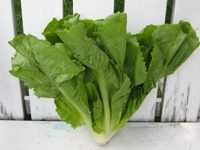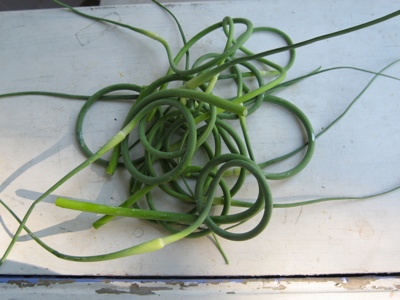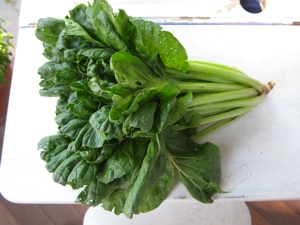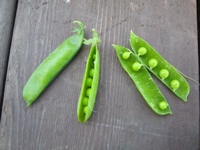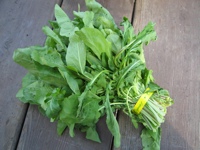Hello Everyone,
Well the fields have finally dried out enough to be plowed, so I’ve been spending a lot time on the large tractor this past week preparing ground, some for the second time. While I waited for fields around the main farm to dry I moved the tractor to my new rented field in Andover. The soil there is very well drained so it was ready for plowing within 2 days of the heavy rain. Most of the ground at this new field has not been worked for several years and has grown a very dense sod, which will take a considerable time to break down. For this reason I have plowed 5 of the 6 acres I have use of, even though some will not be planted until July and August. I have planted most of the peas I intend to- about 6,000 row feet and 55 lbs. of seed. My workers have planted about 12,000 onion and leek plants and 1,500 lettuce plants. We have begun cutting the seed potatoes into pieces and will begin planting potatoes in the next few days. There are also about 7,000 transplants of broccoli, cabbage, cauliflower, radicchio, and more lettuce that have been moved out of the greenhouse and are hardened off, waiting to be setout in the field. In the next week we will transplanting out these crops as well as starting more in the greenhouse and transplanting many greenhouse starts into larger cells. For anyone thinking about coming to the volunteer work day on May 12, help with greenhouse work will be one of the tasks for which I will greatly appreciate your assistance. It’s also time to plant many crops that are direct seeded into the field, such as carrots, beets, parsnips, spinach, and Swiss chard, to name just a few. It’s too early in the season to be this far behind, but the nature of farming is bound to the vagaries of the climate. Wish me luck catching up, and come out and lend a hand if you’re so inclined! –Farmer John
Day: August 7, 2007
Letter from John April 15, 2007
Hello everyone!In the 2 weeks since my last update we have finished cleaning up the fields and I was able to plow about 4 acres of ground. I also cultivated the garlic which is growing quite nicely. The shallots which like the garlic are planted in the fall are just beginning to come up. Unfortunately I have not been able to plant any peas yet, as the ground remains too cold. While conventional farmers, using fungicide treated seed, can plant peas without much regard for soil temperature, organic growers must be a little more careful or the seed will simply rot. The heavy rains from the Nor’easter will delay planting still further, as it will be too wet to get into most of my fields until at least the end of the week. We will also be delayed in planting onions and potatoes until next week. The good news is that there is no more rain in the forecast for the next 2 weeks and the temperatures are finally headed for the upper 50’s and 60’s!!! I have been planting lots of seeds in the greenhouse, including celery root, kohlrabi, kale, bok choy, parsley, ground cherries, and more lettuce and tomatoes. We have begun transplanting the early tomatoes into larger cell flats, which has increased the overcrowding in an already full greenhouse. As soon as the weather improves a bit we will be able to move some of the hardier plants such as the onions and cabbage family onto benches outdoors where they will be hardened off for planting out into the field. I still have a lot of greenhouse planting to do- herbs, flowers, and more lettuce and broccoli to name just a few. There are also almost 2,000 eggplant and pepper plants to be transplanted soon! So keep your fingers crossed or maybe say a little prayer for a nice stretch of warm, dry weather!–Farmer John
Letter from John April 1, 2007
Hello Everyone!
Well the robins are arriving, the crocuses are blooming and the spring peepers are peeping, so it must be spring! March was unusually cold, at least until last week. I began planting in the greenhouse on March 10th, about a week later than I would have liked. I just couldn’t bear to turn the heat on in the greenhouse when it was still in the low teens overnight. At present there are onions, leeks, broccoli, cauliflower, cabbage, radicchio, and tomatoes up and growing nicely. The eggplant and peppers are just beginning to germinate. In the next 2 weeks I will be planting celery and celery root, kohlrabi, kale, parsley, ground cherries and tomatillos as well as more tomatoes and lettuces in the greenhouse. In the field we have been working on cleaning up from last season- removing posts and cables used for trellising and plastic mulch and drip tape. I have not been able to start plowing yet, because the ground is still to wet from that late season snowfall. I hope to be able to start preparing ground later this week, if it doesn’t rain too much. In the next 2 weeks it will be time to plant fava beans and peas in the field. We are also busy doing maintenance and repairs on the trucks, tractors and other equipment. That’s all for now, stay tuned for the next update in 2 weeks!
— Farmer John
Escarole
Escarole, and the curly frisee that was the other choice, are members of the chicory family. Other chicories are endive and radicchio. These are hearty greens with a firm texture and slightly bitter taste.
Escarole can be eaten raw in salads, but it is best cooked. Slice into ribbons and cook quickly to retain its edge or saute low and slow with some garlic scapes to sweeten.
Escarole is famously paired with white beans in soups and casseroles. It can withstand a lot of cooking and a lot of strong flavors.
Frisee (not pictured), should be eaten raw in salds
Radishes
Radishes are eaten raw. They range in flavor from a mild spice to full-flegged heat, but a radish is always cool and crisp. They are a great way to wake up the palate on hot, humid Jersey days. True believers just rinse and eat like a carrot. The French arrange them in bowls and dip in butter and salt. The English slice them paper thin and put into tea sandwiches. They are excellent sliced into salads or grated into slaws (see kohlrabi post). They are a colorful, spicy addition to a vegetable & dip platter.
Garlic Scapes
Welcome to one of the perks of CSA membership. The garlic scape is the top of the garlic plant, sort of like a big chive, but with more garlic flavor. Scapes keep very well in the fridge. Chop them and saute them much like you would use garlic. I have cooked the whole thing slowly in olive oil and they become soft and mellow. You can throw a whole scape into pasta sauce or soup. Experiment and enjoy.
Tatsoi
Tatsoi is an Asian mustard green. It can be treated like any Asian green–chopped and stir fried with oil and garlic. Throw in some ginger and soy sauce if you like. You could stir fry this with some of the bok choy and garlic scapes. Don’t forget to cook the stems.
I like Asian greens quickly wilted in some oil with garlic and ginger. I throw them in a bowl and top with some dumplings, a splash of dumpling sauce and a sprinkling of flax seeds.
You can get a large assortment of frozen Chinese and Japanese dumplings at East West Market on Bellville Ave. in Bloomfield. I like the pork and leek, but the have vegetable, shrimp, chicken, etc. Head to the sauce ailse and pick up the handy dumpling sauce. Easy peasy and really good.
Snap Peas
Also called Sugar Snap Peas, these are one of the pea varieties with an edible shell. They make a good snack and are tasty with a dip. Chop them and add to salads. I put them into a potato salad once and it was really good.
They can also be cooked. Snap off the stem and pull the string to the end. Cook with a little water and butter until bright green and tender, 2-3 minutes.
English Peas
English peas, or shelling peas, are one of the harbingers of spring. Nothing quite matches the sweet crunch of a freshly picked pea. Timing is everything with peas. Pick it too soon and the peas are too small, wait too long and their sugars turn starchy. Heaven forbid you eat a pea several days past its prime–it is hard and bitter. They are also much better shortly after harvesting, so I urge you to eat them up!
To shell, simply open along the seam and scrape the peas out with your thumb. Collect in a beautiful bowl. Steam ever so slightly–no need to over cook– or shake in a shallow pan of boiling water. A couple of minutes should do it. They will turn bright green. The peas are great as is, but a bit of butter doesn’t hurt.
Arugula
Arugula is a spicy salad green. Wash and spin and use in salads. Its nice in a mix of salad greens, but makes a lovely salad by itself. Arugula’s peppery taste can stand up to lots of other bold flavors–intense vinegars, lemon, olives, salt, shaved parmesan, nuts, avocado.
Arugula can also be cooked. Chop it and fold it into sauces or cook with other greens.

